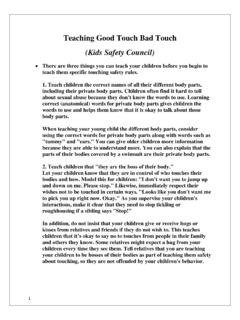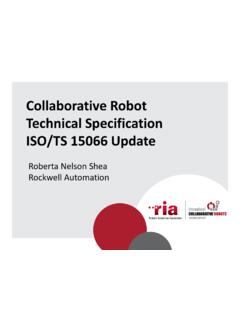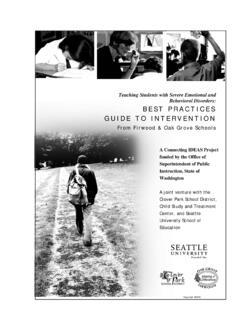Transcription of Core practical 11: Investigate the presence of different ...
1 EDEXCEL Biology B Teacher Resource Pack 2 Pearson Education Ltd 2016 This document may have been altered from the original 1 Core practical 11 Teacher sheet Investigate the presence of different chloroplast pigments using chromatography practical activities have been safety checked but not trialled by CLEAPSS. Users may need to adapt the risk assessment information to local circumstances. Core practical 11: Investigate the presence of different chloroplast pigments using chromatography Objective To separate and identify photosynthetic pigments from leaf chloroplasts Safety Specification links Petroleum spirit is highly flammable, may cause severe lung damage if swallowed and is an irritant. Vapour may cause drowsiness or dizziness. Wear eye protection. Extinguish any naked flames close by.
2 Do not inhale fumes, stopper containers and use in a well-ventilated area. Propanone is highly flammable and is an irritant to eyes and skin. Vapours may cause drowsiness and dizziness. Wear eye protection. Extinguish any naked flames close by. Do not inhale fumes. Use in small amounts in a well-ventilated area. practical techniques 1, 3, 7, 8 CPAC 1a, 2a, 2b, 3a, 3b, 4a, 4b, 5b Procedure Notes on procedure Chromatography is a separation process that relies upon the differential distributions of a mixture between a mobile liquid phase (the chromatography solvent) and a stationary solid phase (in this case, paper). 1. Take a piece of chromatography paper of a suitable size to fit the full length of a boiling tube without touching the sides. Draw a pencil line about 25 mm from the bottom edge.
3 2. Wearing eye protection, grind a few leaves in a mortar with a maximum of 10 cm3 of propanone to extract the pigments. The extract should be as concentrated as possible. Work quickly to minimise evaporation. 3. Push any pieces of plant material to one side with a spatula. Use a fine pipette tip or capillary tube to take up a small amount of extract. Place one small drop of this extract in the centre of the pencil line and allow to dry before adding another drop on top. Build up a pigment spot that is as small as possible but dense enough that it contains sufficient pigment. Avoid touching the chromatography paper as fingerprints may interfere with the solvent movement. Begin step 4 while you wait for the spots to dry. 4. Wearing eye protection, carefully pour the chromatography solvent into a boiling tube to a depth of no more than 1 cm.
4 Insert the bung. As an alternative to this practical , you could carry out an investigation using thin layer chromatography by following one of the many suitable protocols available online. This procedure instead uses paper chromatography, which relies on materials that are cheaper and more readily available. It is good practice to ask students to carry out some research and write a risk assessment for this practical , particularly regarding the use of the solvents. It is preferable for students to carry out the chromatography individually. The extraction stage can be done in groups as each extract should provide enough for several students. Class results are more interesting if each group uses a different type of leaf. It should be possible for students to take the pigment extract straight from the mortar, but if it proves difficult to prevent contamination with lumps of solid matter it may be necessary to filter the extract through muslin.
5 Pigments may be more visible if the chromatogram is run in the dark or if tubes are covered with foil to avoid degradation by sunlight. Chromatography solvent is very toxic to aquatic organisms. Do not allow students to pour waste into the sink. EDEXCEL Biology B Teacher Resource Pack 2 Pearson Education Ltd 2016 This document may have been altered from the original 2 Core practical 11 Teacher sheet Investigate the presence of different chloroplast pigments using chromatography practical activities have been safety checked but not trialled by CLEAPSS. Users may need to adapt the risk assessment information to local circumstances. 5. When the chromatography paper is ready, suspend it inside the boiling tube by pinning it to the underside of the bung or by trapping it in a split bung.
6 The bottom of the paper should be dipped into the solvent but the pigment spot must not be immersed in the solvent at any time. 6. The solvent front should rise up the paper, evenly separating out different pigments. When it is close to the top of the tube after around 10 minutes, remove it from the solvent and quickly mark the position of the solvent front using a pencil. Allow the chromatogram to dry in a well-ventilated area, preferably in the dark. 7. When dry, examine the chromatogram. Calculate the Rf values for each pigment using the procedure shown in fig A. Answers to questions 1. The Rf value of a particular substance should always be the same provided the chromatogram is treated in the same manner in each case. different paper, solvent and running conditions may affect the Rf values.
7 While the values in this table are for the same solvents, there may be slight differences. 2. It would be more accurate to use pure extracts of the pigments as reference standards and test them alongside the leaf extract in an identical chromatography procedure then compare Rf values. 3. Some substances do not move at all because they are insoluble in the mobile phase/solvent. 4. Each of the pigments absorbs and captures energy from light from particular areas of the spectrum. As a result, far more of the energy from the light falling on the plant can be used than if only one pigment was present. EDEXCEL Biology B Teacher Resource Pack 2 Pearson Education Ltd 2016 This document may have been altered from the original 1 Core practical 11 Student sheet Investigate the presence of different chloroplast pigments using chromatography practical activities have been safety checked but not trialled by CLEAPSS.
8 Users may need to adapt the risk assessment information to local circumstances. Core practical 11: Investigate the presence of different chloroplast pigments using chromatography Objective To separate and identify photosynthetic pigments from leaf chloroplasts Safety All the maths you need Petroleum spirit is highly flammable, may cause severe lung damage if swallowed and is an irritant. Vapour may cause drowsiness or dizziness. Wear eye protection. Extinguish any naked flames close by. Do not inhale fumes. Stopper containers and use in a well-ventilated area. Propanone is highly flammable and is an irritant to eyes and skin. Vapours may cause drowsiness and dizziness. Wear eye protection. Extinguish any naked flames close by. Do not inhale fumes. Use in small amounts in a well-ventilated area.
9 Use ratios, fractions and percentages. Equipment pestle and mortar boiling tube and bung with pin boiling tube rack measuring cylinder spatula pencil and ruler fine tube for pigment loading a few leaves chromatography paper propanone (pigment extraction solvent) chromatography solvent (1 : 9 mix of propanone : petroleum spirit) Diagram fig A An example of how Rf values are calculated. EDEXCEL Biology B Teacher Resource Pack 2 Pearson Education Ltd 2016 This document may have been altered from the original 2 Core practical 11 Student sheet Investigate the presence of different chloroplast pigments using chromatography practical activities have been safety checked but not trialled by CLEAPSS. Users may need to adapt the risk assessment information to local circumstances.
10 Procedure Chromatography is a separation process that relies upon the differential distributions of a mixture between a mobile liquid phase (the chromatography solvent) and a stationary solid phase (in this case, paper). 1. Take a piece of chromatography paper of a suitable size to fit the full length of a boiling tube without touching the sides. Draw a pencil line about 25 mm from the bottom edge. 2. Wearing eye protection, grind a few leaves in a mortar with a maximum of 10 cm3 of propanone to extract the pigments. The extract should be as concentrated as possible. Work quickly to minimise evaporation. 3. Push any pieces of plant material to one side with a spatula. Use a fine pipette tip or capillary tube to take up a small amount of extract. Place one small drop of this extract in the centre of the pencil line and allow to dry before adding another drop on top.
















